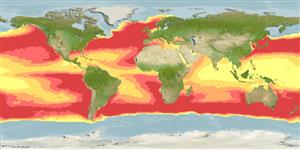Classification / Names
Common names from other countries
Main reference
Size / Weight / Age
Max length : 333 cm TL male/unsexed; (Ref. 26340); max. published weight: 2.3 t (Ref. 47360)
Environment
Marine; pelagic-oceanic; oceanodromous (Ref. 51243); depth range 30 - 480 m (Ref. 86942), usually 30 - 70 m (Ref. 90102)
Climate / Range
Subtropical; 12°C - 25°C (Ref. 37040), preferred 27°C (Ref. 107945); 75°N - 65°S, 180°W - 180°E
Distribution
Warm and temperate zones of all oceans. Eastern Pacific: British Columbia, Canada (Ref. 2850) to Peru and Chile (Ref. 5530). Western Pacific: Japan to Australia (Ref. 86345). Eastern Atlantic: Scandinavia to South Africa (occasionally western Baltic, Mediterranean). Western Atlantic: Newfoundland, Canada (Ref. 7251) to Argentina (Ref. 36453).
Countries | FAO areas | Ecosystems | Occurrences | Introductions
Short description
Dorsal
spines
(total): 0;
Dorsal
soft rays
(total): 15-18;
Anal
spines: 0;
Anal
soft rays: 14 - 17. The scaleless body is covered with extremely thick, elastic skin. The caudal fin is replaced by a rudder-like structure called 'clavus'. Dorsal and anal fins very high with short base; in swimming, these fins are flapped synchronously from side to side and can propel the fish at surprisingly good speed. Pectorals small and rounded, directed upward (Ref. 6885). Mouth very small; teeth fused to form a parrot-like beak. Gills 4, a slit behind the last; gill openings reduced to a small hole at the base of the pectoral fins. Gas bladder absent in adults.
IUCN Red List Status (Ref. 115185)
Threat to humans
Poisonous to eat (Ref. 13513)
Human uses
Fisheries: minor commercial
More information
ReferencesAquacultureAquaculture profileStrainsGeneticsAllele frequenciesHeritabilityDiseasesProcessingMass conversion
Tools
Special reports
Download XML
Internet sources
Estimates of some properties based on models
Phylogenetic diversity index
PD50 = 0.8125 many relatives (e.g. carps) 0.5 - 2.0 few relatives (e.g. lungfishes)
Trophic Level
3.7 ±0.47 se; Based on food items.
Resilience
Medium, minimum population doubling time 1.4 - 4.4 years (tmax = 8 (in captivity); Fec=300 million (batch fecundity))
Vulnerability
Very high vulnerability (82 of 100)
Price category
